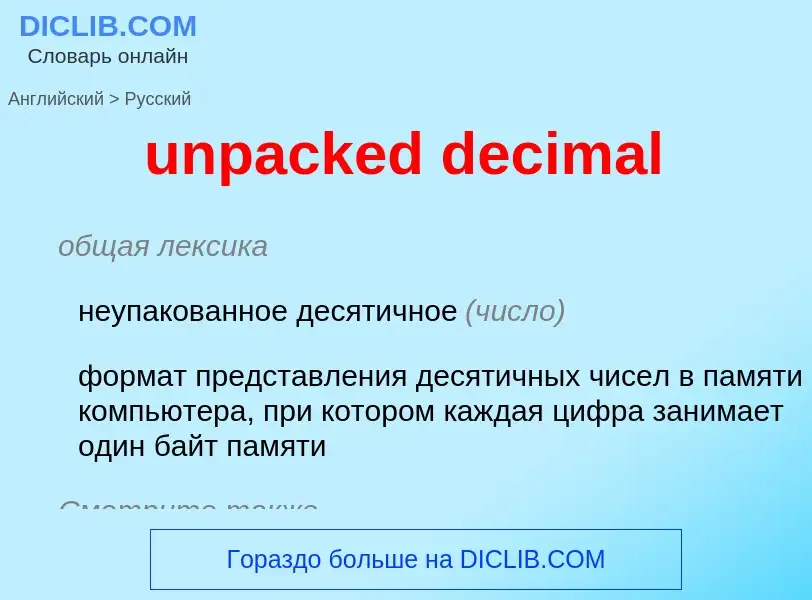Übersetzung und Analyse von Wörtern durch künstliche Intelligenz ChatGPT
Auf dieser Seite erhalten Sie eine detaillierte Analyse eines Wortes oder einer Phrase mithilfe der besten heute verfügbaren Technologie der künstlichen Intelligenz:
- wie das Wort verwendet wird
- Häufigkeit der Nutzung
- es wird häufiger in mündlicher oder schriftlicher Rede verwendet
- Wortübersetzungsoptionen
- Anwendungsbeispiele (mehrere Phrasen mit Übersetzung)
- Etymologie
unpacked decimal - Übersetzung nach Englisch
общая лексика
неупакованное десятичное (число)
формат представления десятичных чисел в памяти компьютера, при котором каждая цифра занимает один байт памяти
Смотрите также
общая лексика
упакованное (двоично-кодированное) десятичное число, упакованный десятичный формат
один из способов компактного машинного представления десятичных чисел, использующий четыре бита для кодирования каждой десятичной цифры. Знак в упакованном десятичном числе занимает четыре бита в его самом правом наименее значимом байте. Такие числа используются на мэйнфреймах для экономических расчётов
синоним
Смотрите также
общая лексика
десятичная точка, десятичная запятая
в принятой в США нотации - точка, отделяющая целую часть числа от десятичной дроби. Позицию десятичной точки могут обозначать и другие знаки, например запятая
точка в десятичной дроби, отделяющая целое от дроби
десятичная запятая
десятичная точка
Смотрите также
Wikipedia
Decimalisation or decimalization (see spelling differences) is the conversion of a system of currency or of weights and measures to units related by powers of 10.
Most countries have decimalised their currencies, converting them from non-decimal sub-units to a decimal system, with one basic currency unit and sub-units that are to a power of 10, most commonly 100, and exceptionally 1000; and sometimes at the same time changing the name of the currency or the conversion rate to the new currency. Today, only two countries have non-decimal currencies: Mauritania, where 1 ouguiya = 5 khoums, and Madagascar, where 1 ariary = 5 iraimbilanja. However, these are only theoretically non-decimal, as, in both cases, the value of the main unit is so low that the sub-units are too small to be of any practical use and coins of the sub-units are no longer used. Russia was the first country to convert to a decimal currency when it decimalised under Tsar Peter the Great in 1704, resulting in the ruble being equal to 100 kopeks.
For weights and measures, this is also called metrication, replacing traditional units that are related in other ways, such as those formed by successive doubling or halving, or by more arbitrary conversion factors. Units of physical measurement, such as length and mass, were decimalised with the introduction of the metric system, which has been adopted by almost all countries (with the prominent exceptions of the United States, and, to a lesser extent, the United Kingdom and Canada). Thus, a kilometre is 1000 metres, while a mile is 1,760 yards. Electrical units are decimalised worldwide. Common units of time remain undecimalised; although an attempt was made during the French Revolution, this proved to be unsuccessful and was quickly abandoned.


![via=scan published by [[Harvard-Smithsonian Center for Astrophysics]] }}</ref> via=scan published by [[Harvard-Smithsonian Center for Astrophysics]] }}</ref>](https://commons.wikimedia.org/wiki/Special:FilePath/Interpunct as decimal point in Henderson 1839.png?width=200)

